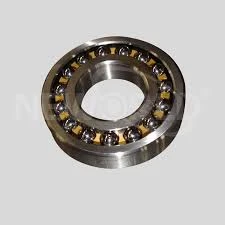
Nov . 17, 2024 09:52 Back to list
Comparison of Spherical Roller Bearings and Tapered Roller Bearings for Optimal Performance
Spherical Roller Bearings vs. Tapered Roller Bearings
Choosing the right type of bearing for a particular application is critical in ensuring optimal performance and longevity of machinery. Among the most commonly used bearing types are spherical roller bearings and tapered roller bearings, each offering distinct advantages depending on the operational requirements.
Spherical roller bearings are designed to accommodate both radial and axial loads in either direction. They consist of an inner ring, an outer ring, and a set of spherical-shaped rollers that can pivot within the outer ring. This unique design allows for self-alignment, making spherical roller bearings particularly advantageous in applications where shaft misalignment might occur due to bearing housing distortions or mounting errors. They are commonly used in heavy-duty applications such as wind turbines, heavy machinery, and industrial gearboxes, where high load capacities and the ability to withstand shock loads are essential.
Conversely, tapered roller bearings are designed to handle both radial and axial loads but with a focus on axial load support. These bearings feature tapered rollers that approximate the shape of a cone and are oriented such that the line of action of the load intersects at a common point. This design allows for better load distribution and increased efficiency under high-speed conditions. Tapered roller bearings are widely used in automotive applications, especially in wheel hubs, where they ensure stability and durability under varying load conditions.
spherical roller bearing vs tapered roller bearing

When comparing the two, several factors emerge that can influence the choice of bearing. Spherical roller bearings excel in applications where there may be misalignment, high loads, and continuous oscillation. They are ideal for installations that demand robustness. In contrast, tapered roller bearings are more appropriate for applications requiring precise axial positioning and high-speed operation.
Another key differentiator lies in maintenance and installation. Spherical roller bearings are typically easier to install and maintain due to their self-aligning capabilities. Tapered roller bearings, on the other hand, require careful adjustment during installation to ensure proper load distribution and performance.
In summary, the choice between spherical roller bearings and tapered roller bearings depends heavily on the specific application requirements, including load conditions, alignment precision, and speed. Understanding the strengths and limitations of each bearing type can significantly impact the efficiency, reliability, and longevity of machinery. Proper selection not only enhances performance but also reduces downtime and maintenance costs, ultimately leading to improved operational efficiency.
Latest news
-
Premium Deep Groove Ball Bearings | High Speed & Reliability
NewsAug.29,2025
-
Durable Scaffolding Clamps - Secure & Reliable Tube Connectors
NewsAug.28,2025
-
Common Failures in Thrust Ball Bearings and Solutions
NewsAug.22,2025
-
How Tapered Roller Bearings Can Take Shock Loads
NewsAug.22,2025
-
Angular Bearings in High-Precision Spindles
NewsAug.22,2025
-
The Impact of Misalignment on Cylindrical Roller Bearing Performance
NewsAug.22,2025
